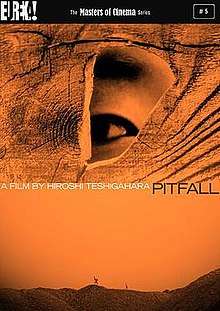Pitfall (1962 film)
Pitfall (おとし穴, Otoshiana), a.k.a. The Pitfall and Kashi To Kodomo, is a 1962 Japanese film directed by Hiroshi Teshigahara, written by Kōbō Abe. It was Teshigahara's first feature, and the first of his four film collaborations with Abe and Takemitsu, the others being Woman in the Dunes, The Face of Another and The Ruined Map. Unlike the others, which are based on novels by Abe, Pitfall was originally a television play called Purgatory (Rengoku).[2] The film has been included in The Criterion Collection.
| Pitfall | |
|---|---|
 | |
| Directed by | Hiroshi Teshigahara |
| Produced by | Tadashi Ono[1] |
| Screenplay by | Kōbō Abe[1] |
| Based on | Rengoku by Kōbō Abe[1] |
| Starring |
|
| Music by |
|
| Cinematography | Hiroshi Segawa[1] |
| Edited by | Fusako Shuzui[1] |
Production company | Teshigahara Production[1] |
| Distributed by | Japan Art Theatre Guild |
Release date |
|
Running time | 97 minutes |
| Country | Japan |
Plot
Pitfall is set against the background of labour relations in the Japanese mining industry, but the film owes as much to surrealism as it does to "socially aware" drama. The mine in the film is divided into two pits, the old one and the new one, each represented by a different trade union faction. A mysterious man in white, whose identity we never learn, murders an unemployed miner who bears an uncanny resemblance to the union leader at the old pit and bribes the only witness to frame the union leader of the new pit. The two union leaders go to the murder scene to investigate only to come across the body of the witness, who has subsequently been killed by the man in white. They blame one another and begin a fight which ends in both their deaths. The film ends with the man in white observing them before riding off on his motorcycle, satisfied his mission is complete. Beyond this realistic plot, Pitfall shows us the realm of the dead as well as the living, as the ghosts of the victims look on, powerless to intervene in events and bring the truth to light.
Cast
- Hisashi Igawa - Miner / Otsuka
- Sumie Sasaki - Shopkeeper
- Sen Yano - Toyama
- Hideo Kanze - Policeman
- Kunie Tanaka - Man in white suit
- Kei Satō - Reporter
Production
The film's focus on the exploitation of coal miners was likely influenced by Teshigahara and Abe's political leanings, and their sympathy with the Tokyo demonstrations in 1960 against Anpo.[3]
The film was shot in Kyūshū, and incorporates stock footage of mining disasters and starvation that had afflicted the area.[3] Many of the visual devices and themes are similar to the contemporaneous work of Shōhei Imamura, whose 1959 film My Second Brother also featured Kyūshū coal miners.[3]
Teshigahara often disagreed with his film crew, and fired two assistant directors who did not wish to include the scene in which the policeman rapes the shopkeeper.[3]
Release
Pitfall was first distributed by Japan Art Theatre Guild (ATG) on a limited release on July 1, 1962.[1] ATG had only began distributing films on April 20, 1962.[1]
The film then appeared to be acquired by Toho for wider release on June 6, 1964.[1] The film was released in the United States in 1964 through Toho International.[1]
References
- Galbraith IV 2008, p. 211.
- The Word and The Image: Collaborations between Abe Kôbô and Teshigahara Hiroshi - Yuji Matson
- James Quandt, Video Essay included on the Criterion Collection DVD release of Pitfall
- Booklet and commentary by Tony Rayns to the Eureka Masters of Cinema DVD edition.